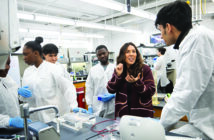Med students provide help for aslyum seekers.
The US has opened its doors to immigrants fleeing persecution and violence since its founding. But the process for attaining asylum is complex and lengthy, and only 30 to 40 percent of applicants receive refugee status. That rate goes up to 90 percent, however, for asylum seekers with a medical affidavit, which documents physical evidence of abuse or torture—so medical assessments significantly influence cases.
The stakes are high: if denied, immigrants must return to their home country, where they may be harmed. Doctors lend their power and credibility through the medical affidavit, and now, with training from the Brown Human Rights Asylum Clinic (BHRAC), some Rhode Island physicians have that authority.
On a Saturday in February, 72 doctors, residents, medical students, and others packed a second-floor classroom at Alpert Medical School for the BHRAC’s first-ever training day, learning skills such as affidavit writing, human rights and asylum law, and evaluating scars. As the last session wrapped up, clinic cofounder Rebecca Slotkin MD’16 announced, “Before today, maybe three or four physicians in the state of Rhode Island were qualified to assess asylum applicants. Now?” She gestured to the crowd. “There are dozens.”
Asylum assessments differ markedly from regular examinations: doctors look for years-old evidence of trauma, and must account for all scars and abnormalities, even those unrelated to abuse. Such exams can take hours, and often practitioners can’t use the space in which they normally work because the applicants aren’t patients.
This is where the BHRAC can help. In addition to connecting clients with qualified physicians and affidavits at no charge, it has arranged with Clínica Esperanza, a Providence clinic for uninsured adults, to donate space for assessments as needed. Before the BHRAC, asylum seekers had to travel to Boston or New York City to get affidavits, increasing the time and cost of an already demanding process. The difficulties of traveling to and navigating an unknown city may have deterred asylum seekers from taking the trip at all.
Trained Alpert medical students observe assessments and draft affidavits, which are routinely 20 pages long and must be thorough and exact. “Most of the time when you’re a med student, you’re just tagging along and observing—the patient is doing you a favor,” Caitlin Ryus, MPH MD’17, a BHRAC codirector, says. “In your first few years of medical school you can take the sexual history and you can do some first aid, and that’s about it. But this is something that’s tangible help for someone. Your observation and documentation are what help them.”
Ryus says the group is hoping to partner with a radiologist so they can do x-rays, which can show evidence of old fractures and breaks resulting from abuse—things that can’t be seen from a surface exam, and can be powerful evidence. She adds that they expect the number of clients to increase as word spreads of the free assessments. “We originally expected clients to be referred through PHR,” says Ryus, referring to Physicians for Human Rights, a national organization that helps asylum seekers find legal counsel and medical care. “But at Clínica, we ran into two different women seeking asylum who needed assessments,” she says. “The need in the community may be greater than we had thought.”




